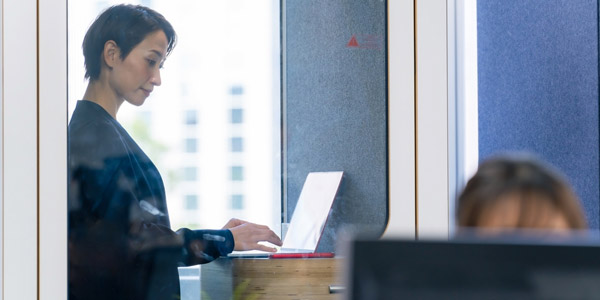Trying to be productive with lots of noisy distractions can be futile. Eventually, it becomes clear that the noise adversely impacts your genuine effort and hinders your productivity.

So, if you want to concentrate better and boost your productivity, soundproofing your office is the way to go. Fortunately, you don’t have to spend much money to do it.
Check out the five cheapest ways to soundproof your office at ZERO extra cost, and pick one that works best for you.
Root Cause of Stress-Inducing Noise in the Office
Noise has been linked to low productivity, headaches, and stress. However, there are three main sources of noise:
- Ambient background noise
- External noise; and
- Occupational noise
The ambient background noise is the most challenging source because you have absolutely no control over the noise level. Most appliances are noisy. For instance, the AC unit, refrigerator, water faucet, etc., are not whisper quiet.
Also, external noise sources such as traffic, ongoing construction sites, and noise from adjacent rooms or offices contribute significantly to stress-inducing noise in the office. While it might seem moderate and inconsequential, it can take a toll on your productivity.
Similarly, occupational noise comes from quotidian equipment operated during working hours. For example, a typewriter creates about 73 dB(A) noise, slightly louder than a normal human conversation. Some staplers are no different and can be annoying, especially when there’s a lot of paperwork.
Step-by-Step Guide on How to Soundproof Your Office at Zero Extra Cost

Shield Air Vents
One of the easiest and most cost-effective ways to soundproof your home office is covering up any gaps to reduce the amount of noise migrating into your space. However, sound experts strongly advise workers to avoid completely blocking the air vents as they are essential for improving your home office’s air quality.
Also, you want to use something other than heavy furniture or bookshelves to barricade these vents. Instead, it’s best to cover the vents loosely with pull-away furniture, storage boxes, folders, etc.
Seal holes or cracks in the wall
Either small or large openings, any hole in the wall creates the perfect passage for disturbing noise. Repairing the cracks and crevices on our office’s wall can help dampen the noise significantly.
It’s important to use the right filler material, epoxy, or caulking, to fill the cracks and crevices. This DIY project involves identifying and repairing every hole on the wall for the best results. Consequently, it might require a couple of hours from start to finish.
Use rugs and other soft furnishings
As part of the trend, most homes feature hard flooring surfaces, which offers some interesting benefits. However, these laminated, tiled, or solid wood flooring do not offer any degree of noise control.
Instead, they significantly ramp up the noise level since trespassing sound waves bounce off the hard surfaces causing annoying echoes.
Thus, the simple trick here is adding plush rugs, soft seating, and cushions to absorb unwelcome sound waves and prevent boisterous echoes. It’s best if these new additions match or improve your existing home office decor to avoid making your space look out of trend.
Hang canvas artwork and other decorative items
Like your home office’s hard flooring surface, walls are hard enough to reflect unsolicited sound waves creating stress-induced noise.
Although the standard option is installing sound insulation panels, a cheaper alternative is putting some canvas art on the wall. Another cost-effective option is pinning a corkboard to absorb invading sound waves for a serene workspace.
Use a draft excluder
If you own a draft excluder, place it under your home office door. This accessory is perfect for keeping the chills out and blocking out external noise.
If you can’t get your hands on this purpose-built accessory, you can use folded towels, a rolled-up blanket, or a cushion to seal the gap between your workspace door and the floor.
Air Purifiers & Fans
Adding an air purifier to your home workspace can be an excellent way of masking unsolicited din taking a toll on your productivity. These appliances are primarily designed to improve your indoor air quality. While they are great for their main purpose, they create a noise that can double as white noise to cancel out the unwanted ambient noise.
Unlike air purifiers, box or ceiling fans help improve air circulation to create a cool working environment. However, they tend to generate white noise to keep you less distracted and more productive.
You don’t have to purchase a new air purifier; a table or ceiling fan will do the trick. The intention is to introduce white noise, which takes your mind off the external noise source.
And, if this does not sound like a great idea, you can consider the next option – a white noise generator or application.
Use a white noise generator or application
This is the quickest way to be productive in a noisy environment. There are many white noise applications for computers and smartphones to ensure you’re less distracted.
They effectively block out the outside commotion regardless of where you are. Several studies have proven the calming effect of white noise on workers, which ultimately leads to improved productivity. Most importantly, use comfortable headphones if you will be using the application for an extended period.
Related FAQs
How much is required to soundproof your workspace effectively hinges on various factors, such as the type of materials needed, office size, and soundproofing method. Nonetheless, there are cost-effective solutions to unsolicited noise affecting your productivity. You can use materials with sound-absorbing properties to help dampen the noise.
There are purpose-built soundproofing curtains, one of the affordable options for people on a tight budget. However, putting thick curtains in the path of trespassing external noise can reduce the disturbance.
One of the easiest ways to solve this problem is to move your desk far away from the shared wall or noise source. Also, adding some resistance to the noise path can muffle your neighbor’s din. Other soundproofing methods include:
● Sealing cracks and gaps in the floor, ceiling, and walls.
● Insulating the ceiling and walls.
● Adding acoustic panels and similar soundproofing materials.
Conclusion
There are several ways to soundproof your home office for a quiet and productive working environment. I’ve highlighted the cheapest way to soundproof an office without additional cost.
But, before attempting to soundproof your office, it is crucial first to identify the specific noise sources to ensure that the chosen soundproofing methods and materials effectively address the problem.
However, if the noise in your office is ambient or occupational, using a white noise app may be a quick and easy solution that does not require additional expenses or effort.
Related Resources:
